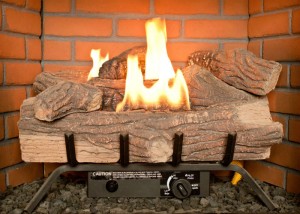Gas fireplaces continue to grow in popularity due to their energy savings, ease of use, and low maintenance. Gas logs are particularly popular due to their ability to recreate the look and feel of a wood burning fire at the push of a button. While there is significantly less work with a gas fireplace compared to a wood burning one, gas fireplaces still need regular cleaning and upkeep.
Although gas logs do not have ashes or soot to remove after each use, they should be regularly cleaned to maintain efficiency and safety. Cleaning a gas log is an easy process, but special care should be taken to ensure that no fireplace parts or pieces are damaged.
Cleaning your gas log
The interior and exterior portions of your gas log fireplace should be cleaned at least twice a year to prevent an excessive buildup of soot or dust. However, only cleaners that are specially designed for gas fireplaces should be used. Other chemical or homemade cleaning agents may have abrasive qualities on the gas, metal, or ceramic parts of the fireplace. In addition, the chemicals in non-fireplace cleaners may react when the fireplace is relit for use. A specialized cleaner can be purchased at many fireplace retailers.
The exterior glass and metal can be wiped down as often as needed using a clean, damp cloth or other specialized cleaner. The burners, control compartments, and ceramic logs can be gently cleaned with a dry cloth or soft bristled paintbrush. A vacuum may also be used, but can should be taken not to shift or move the gas log or its components.
Safety considerations
Before attempting to clean your gas logs, make sure that the gas valve has been completely shut off. Likewise, none of the fireplace components should be warm to the touch from recent use, as the heat may react negatively with the cleaners.
Referencing the manufacturer’s manual is another way to ensure that you are safely and correctly cleaning your fireplace logs and other components. The manual should give detailed instructions on how to safely clean the fireplace with minimal risks.
If you believe you have damaged any of the components of your gas log fireplace during cleaning, contact a professional before using the fireplace again. Even shifting a gas log a few inches can impact both performance and safety.
Do I need a chimney sweep?
Many homeowners are surprised to find that they still need their chimney swept after installing a gas log. Gas appliances still produce small amounts of creosote, which can coat the inside of the flue. In addition, high efficiency modern gas fireplaces are also at risk for incomplete combustion and water condensation.
An improperly sized chimney or flue cannot create sufficient drafting for a gas fireplace, leading to incomplete combustion. When this occurs, gasses such as carbon monoxide may linger in the fireplace. Likewise, accumulating water condensation can be corrosive to the flue lining.
Having a regular chimney cleaning and inspection can help protect your family against any emerging chimney or fireplace issues, as well as ensure that your gas fireplace is still running safely and efficiently. If you have questions about how to clean your gas fireplace or need to schedule a chimney inspection, contact Lord’s Chimney today!


